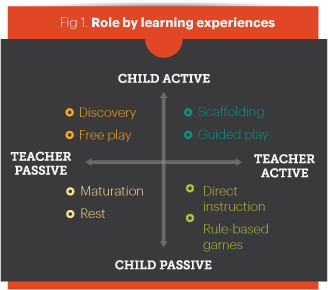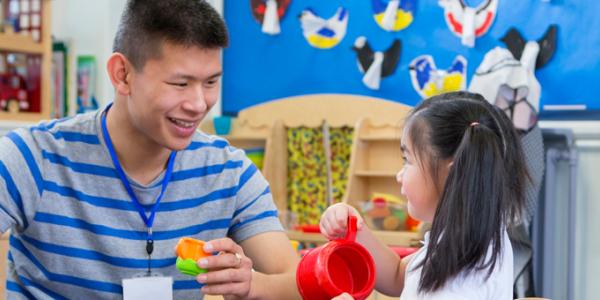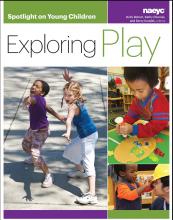Is play merely something fun that all children engage in "just because"? Or is it a way in which children learn? Peter Pizzolongo and Kyle Snow offer a view of play that takes both into account.
Play and Developmentally Appropriate Practice
PETER: Attempts to define or describe play invariably result in conflicting ideas. Some, for example, define play as something that is fun and that all children do. Others define it as a way in which children learn. Support for play as a child's right and as a necessity has a long history. In 1959 the UN Declaration of the Rights of the Child called children's play and recreation a right. The International Play Association in 1977 noted that play is vital to children's development.
KYLE: And the American Academy of Pediatrics (2013) notes that recess is a necessary break to allow children to fully develop in all areas, including academically. It's really an extension of the UN Rights of the Child—that children should be allowed to grow, learn, and develop in a nurturing environment to their fullest potential.
PETER: Play is also ingrained in the NAEYC position statement on developmentally appropriate practice, where it's described as an important way children learn:
Play is an important vehicle for developing self-regulation as well as for promoting language, cognition, and social competence. [Play] gives [children] opportunities to develop physical competence and enjoyment of the outdoors, understand and make sense of their world, interact with others, express and control emotions, develop their symbolic and problem-solving abilities, and practice emerging skills. (NAEYC 2009, 14)
And in a joint position statement, NAEYC and the National Association of Early Childhood Specialists in State Departments of Education (NAECS/SDE) describe how both play and intentional teaching support children learning specific content:
Valued content is learned through investigation, play, and focused, intentional teaching. Children learn by exploring, thinking about, and inquiring about all sorts of phenomena. These experiences help children investigate ‘big ideas,' those that are important at any age and are connected to later learning. (2003, 2)
It is not either play or learning: It is both/and.
KYLE: So play is something that all children do—it's fun—and it's also a way in which children learn. Both are part of developmentally appropriate practice (Copple & Bredekamp 2009).
Research on Play
KYLE: Many researchers have investigated the role of play in young children's learning process (see Singer, Golinkoff, & Hirsh-Pasek 2006). For example, Kathy Hirsh-Pasek and her colleagues note that "playful learning or guided play actively engages children in pleasurable and seemingly spontaneous activities that encourage academic exploration and learning.…Teachers using guided play have a set of learning goals in mind" (Hirsh-Pasek et al. 2009). Some researchers point to the role of play in learning across the domains, such as language development (Weisberg et al. 2013), mathematics (Sarama & Clements 2009), literacy (Roskos & Christie 2001), and social and emotional development (Ashiabi 2007).
Direct Instruction and Exploratory Play
PETER: Many early childhood teachers, including those at the preschool and kindergarten levels, are required to teach academic subjects such as literacy, mathematics, and science. This can be interpreted to mean the subjects must only be taught by direct instruction: children sitting in seats or on the floor for teacher-led whole group instruction on a concept. This is a misunderstanding. Some content or skills are taught by direct instruction, such as the way to use scissors or the names of the numerals. But many academic concepts can also be addressed through exploratory play experiences. Children need both.
Direct instruction involves prescribed activities that are aimed at teaching children specific skills and content knowledge. In some programs, this type of curriculum emphasizes large group instruction, and "play" often consists of structured games to practice newly learned skills (e.g., Virginia Department of Education 2013, 3).
In contrast, in a constructivist approach (in which children construct their own knowledge from their explorations), "small group and individual instruction is predominant" (Virginia Department of Education 2013, 3). Teachers "facilitate children's learning by designing activities, introducing specific materials, and interacting with children in activities and play situations to expand their knowledge and skills" (3). In other words, children can learn academic subjects during their exploratory play experiences.
KYLE: The visual shown below illustrates both the child's role or amount of responsibility for her learning experiences at a given moment and the teacher's role and activity. These roles change throughout the day. Sometimes a child is driving her experience while the teacher is in the background—this is child-guided play (sometimes called free play or discovery learning); at other times both the child and the teacher are active in creating the child's experience (scaffolding and guided play are examples). Both of these experiences are child centered, or at least child focused. But sometimes the teacher, or even another child, plays a more directive role, as in the case of teacher-led direct instruction and rule-based games played by older children.

PETER: In The Intentional Teacher: Choosing the Best Strategies for Young Children's Learning (Epstein 2014), the author describes adult-guided experiences as those in which teachers introduce information and model skills. These experiences proceed "primarily along the lines of the teacher's goals, but [are] also shaped by the children's active engagement" (3). As the figure illustrates, discovery and free play could be seen as child-guided experiences; scaffolding and guided play are adult-guided experiences. Significantly, according to Epstein the definition of child-guided experience includes "strategic teacher support" (3).
KYLE: Kathy Hirsh-Pasek and Roberta Michnick Golinkoff (2015), in their introduction to Spotlight on Young Children: Exploring Play, offer support for guided play as a midground position between play and direct instruction. So, high-quality experiences for young children should include opportunities for children to explore freely and times when teachers construct with children. The challenge for early educators is to intentionally select approaches that are effective in meeting children's learning and development needs (Epstein 2014). Note how the teachers in this vignette use a both/and approach with children.
Implications for Practice
PETER: It is important for teachers and those who work on behalf of young children to recognize the two views of play: Play is a natural phenomenon for all children, and teachers can plan learning experiences for the group and for each child that build on what children naturally do—play. Effective teachers identify which concepts and skills can best be learned through play and for which children, at which ages, at which times in the daily schedule, and other considerations. They also identify what can best be learned through child-initiated play and discovery, when scaffolding is appropriate, and when direct instruction or rule-based games are more appropriate.
Peter Pizzolongo was formerly associative executive director, Professional Development Solutions, at NAEYC. Kyle Snow was formerly senior scholar and director, Center for Applied Research, at NAEYC. Peter and Kyle have both explored the topic of play and learning for several decades and have presented on the topic at numerous conferences.
Learn more about this book
Resources
Recommendations
For Authors & Photographers
Catalog
Webinars
NAEYC Books List

